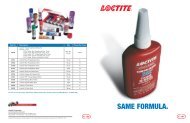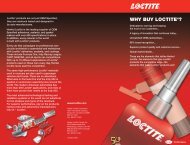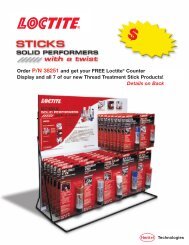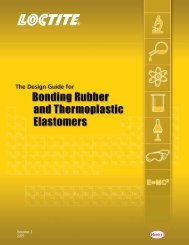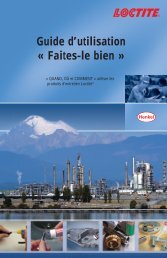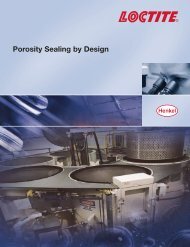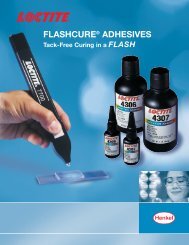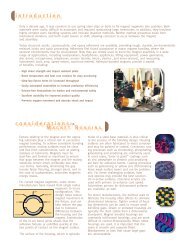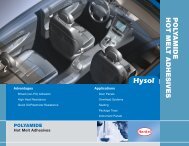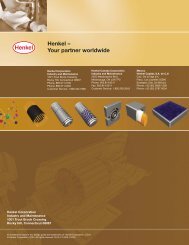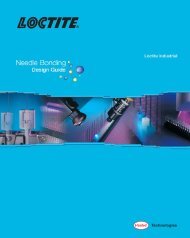PolyamideThermoplasticTrade Names• Adell• Akulon• Amilan• Ashlene• Capron• Celstran• Minlon• Nybex• PA• Rilsan• Ultramid• Vestamid• Vydyne• ZytelManufacturerAdell Plastics, Inc.DSM EngineeringToray IndustriesAshley PolymersAllied-Signal CorporationHoescht CelaneseE.I. DuPontFerro CorporationBay ResinsAtochem N.A.BASFHuls AmericaMonsanto ChemicalE.I. DuPontGeneral DescriptionPolyamide, commonly called nylon, is a semi-crystalline thermoplasticwhich is composed of linear ali<strong>ph</strong>atic segments that are connected byamide linkages. Polyamide can be produced either by the polymerizationof a lactam and an amino acid or a dibasic acid and a diamine. The widevariety of routes by which nylon can be produced, make it possible totailor the backbone to meet specific needs. The various types of nylonare identified by number designations which represent the number ofcarbon atoms in each of the starting materials. For example, nylon 6/6 ismade from the 6-carbon hexamethylenediamine and a 6-carbon adipicacid. Specialty grades available include lubricated, plasticized, flameretardant, and glass filled. In 2004, the price of nylon 6 rangedapproximately from $2.60 to $16.50 per pound at truckload quantities.General PropertiesAll nylons absorb moisture from the atmos<strong>ph</strong>ere, and the water thatenters their structure causes dimensional changes and acts as aplasticizer. These factors must be taken into account when designinga critical part constructed of polyamide. The plastic is inexpensive andhas excellent tensile strength which are reasons for its widespreaduse as a fiber. Unfilled polyamide is biologically inert, and mostgrades have been cleared for food contact use by the FDA. Nylons areresistant to many chemicals, including ketones, fully halogenatedhydrocarbons, esters, fuels, and brake fluids. Polar solvents tend to beabsorbed much like water and strong acids; oxidizing agents andsome concentrated salts will attack them. Gradual oxidation occurs inpolyamide at elevated temperatures, but short-term exposures canexceed 400°F (200°C). Some heat-stabilized grades have been ratedup to 265°F (130°C) for electrical applications, but mechanicalapplication ratings are lower.Typical Properties of PolyamideAmerican EngineeringProcessing Temperature 425°F to 545°F 218°C to 285°CLinear Mold Shrinkage 0.007 to 0.018 in./in. 0.007 to 0.018 cm/cmMelting Point 420°F to 430°F 216°C to 221°CDensity 68.7 to 73.0 lb./ft. 3 1.10 to 1.17 g/cm 3Tensile Strength, Yield 5.0 to 15.0 lb./in. 2 x 10 3 3.5 to 10.5 kg/cm 2 x 10 2Tensile Strength, Break 7.4 to 12.5 lb./in. 2 x 10 3 5.2 to 8.8 kg/cm 2 x 10 2Elongation, Break 10 to 300% 10 to 300%Tensile Modulus 1.0 to 5.0 lb./in. 2 x 10 5 0.7 to 3.5 kg/cm 2 x 10 4Flexural Strength, Yield 9.5 to 19.0 lb./in. 2 x 10 3 6.7 to 13.4 kg/cm 2 x 10 2Flexural Modulus 1.2 to 4.9 lb./in. 2 x 10 5 0.8 to 3.4 kg/cm 2 x 10 4Compressive Strength 1.2 to 14.2 lb./in. 2 x 10 3 0.8 to 10.0 kg/cm 2 x 10 2Izod Notched, R.T. 0.5 to 2.5 ft.-lb./in. 2.7 to 13.5 kg cm/cmHardness R70 - R120 Rockwell R70 - R120 RockwellThermal Conductivity 1.2 to 2.0 BTU-in./hr.-ft. 2 -°F 0.17 to 0.29 W/m-°KLinear ThermalExpansionDeflection Temperature@ 264 psiDeflection Temperature@ 66 psiContinuousService Temperature3.9 to 6.0 in./in.-°F x 10 -5 7.0 to 10.8 cm/cm-°C x10 -5Typical Applications• Automotive – Electrical connectors, wire jackets, emissioncanisters, light duty gears, fan blades, brake fluid and powersteering reservoirs, valve covers, steering column housings,emission control valves, mirror housings• Electronic – Cable ties, plugs, connectors, coil forms, terminals• Consumer goods – Ski boots, ice skate supports,racquetball racquets, ballpoint pens• Miscellaneous – Oven cooking bags, gun stocks,air conditioner hoses, brush bristles, sutures, fishing line,mallet heads, combs, furniture partsSI110°F to 410°F 43°C to 210°C250°F to 420°F 121°C to 216°C175°F to 240°F 79°C to 116°CDielectric Strength 300 to 500 V/10 -3 in. 1.2 to 2.2 V/mm x 10 4Dielectric Constant@ 1 MHzDissipation Factor@ 1 MHzWater Absorption,24 hr.3.1 to 4.1 3.1 to 4.13.1 to 4.1 3.1 to 4.10.25 to 3.0% 0.25 to 3.0%36The <strong>Loctite</strong> ® Design Guide for Bonding Plastics, <strong>Volume</strong> 4
ADHESIVE SHEAR STRENGTH(psi)(MPa)PolyamideUNFILLED RESIN11 rmsROUGHENED15 rmsANTIOXIDANT0.35% Irganox B1171UV STABILIZER0.63% Chimasorb 944IMPACT MODIFIER5% EXL 3607FLAME RETARDANT18% PO-64P44% Antimony OxideLUBRICANT #10.5% Aluminum StearateLUBRICANT #20.5% Mold Wiz INT-33PAGLASS FILLER30% Type 3450Glass FiberTALC FILLER30% Mistron CB TalcPLASTICIZER4% Ketjen-Flex 8450ANTISTATIC5% Larostat HTS 906<strong>Loctite</strong> ® 380 Black Max ® Instant Adhesive,Rubber Toughened245016.9245016.9245016.9245016.9>2200 1700>15.2 11.7145010.0245016.9245016.9245016.9330022.8245016.9<strong>Loctite</strong> ® 401 Prism ® Instant Adhesive,Surface InsensitiveMEDICAL: <strong>Loctite</strong> ® 4011 Prism ®Instant Adhesive, Surface Insensitive450031.0450031.0450031.0450031.0>4500 4500>31.0 31.0450031.0>4500 >4700 2200>31.0 >32.4 15.2>4550 >3100 >31.4 >21.4 <strong>Loctite</strong> ® 401 Prism ®<strong>Loctite</strong> ® 770 Prism ® PrimerMEDICAL: <strong>Loctite</strong> ® 4011 Prism ® /<strong>Loctite</strong> ® 7701 Prism ® Primer160011.0160011.02501.7160011.0>1650 1600>11.4 11.03502.45503.81501.0210014.56504.53502.4<strong>Loctite</strong> ® 414 Super Bonder ®Instant Adhesive, General Purpose410028.3410028.3410028.3410028.3>4300 4100>29.7 28.3460031.7>3750 >4450 2750>25.9 >30.7 19.0>4450 >4100 >30.7 >28.3 <strong>Loctite</strong> ® 330 Depend ® Adhesive,Two-Part No-Mix Acrylic4503.14503.14503.14503.14503.14503.14503.14503.14503.14503.14503.14503.1<strong>Loctite</strong> ® 3105 Light Cure Adhesive,MEDICAL: <strong>Loctite</strong> ® 3311 Light Cure Adhesive14009.714009.714009.714009.714009.714009.714009.710507.214009.714009.714009.714009.7Nylon 6-Capron 8202 produced by Allied-Signal<strong>Loctite</strong> ® 3340 Light Cure Adhesive,UV Cationic Epoxy<strong>Loctite</strong> ® 4305 Flashcure ® Light Cure AdhesiveFLUORESCENT: <strong>Loctite</strong> ® 4307 Flashcure ®Light Cure Adhesive<strong>Loctite</strong> ® H3000 Speedbonder Structural Adhesive, General Purpose<strong>Loctite</strong> ® H4500 Speedbonder Structural Adhesive, Metal Bonder<strong>Loctite</strong> ® 3030 Adhesive, Polyolefin Bonder<strong>Loctite</strong> ® E-00CL Hysol ® Epoxy Adhesive,Low Odor<strong>Loctite</strong> ® E-90FL Hysol ® Epoxy Adhesive,Flexible<strong>Loctite</strong> ® E-30CL Hysol ® Epoxy Adhesive,Glass BonderMEDICAL: <strong>Loctite</strong> ® M-31CL Hysol ®Epoxy Adhesive, Glass Bonder<strong>Loctite</strong> ® E-20HP Hysol ® Epoxy Adhesive,Fast SettingMEDICAL: <strong>Loctite</strong> ® M-21HP Hysol ®Epoxy Adhesive, Fast Setting<strong>Loctite</strong> ® E-214HP Hysol ® Epoxy Adhesive,High Strength2001.4>1150 >7.9 9506.64002.85503.84002.86004.18005.56004.16504.1Adhesive Performance<strong>Loctite</strong> ® 401 Prism ® and 414 Super Bonder ® Instant Adhesives achieved the highest bond strengths,typically in excess of 4000 psi. <strong>Loctite</strong> ® 380 Black Max ® Instant Adhesive, a rubber toughened adhesive,achieved the second highest bond strengths, followed by <strong>Loctite</strong> ® 3105 Light Cure Adhesive. <strong>Loctite</strong> ®4305 Flashcure ® Light Cure Adhesive also achieved a bond strength that resulted in substrate failure.<strong>Loctite</strong> ® Fixmaster ® Rapid Rubber Repair and <strong>Loctite</strong> ® 3651 Hysol ® Hot Melt Adhesive achieved the lowestoverall bond strength. All other adhesives tested generally achieved good bond strength.Surface TreatmentsSurface roughening caused a statistically significant increase in the bond strengths achieved when using<strong>Loctite</strong> ® 330 Depend ® Adhesive, but it did not have any statistically significantly effect with any of theother adhesives. The use of <strong>Loctite</strong> ® 770 Prism ® Primer, in conjunction with <strong>Loctite</strong> ® 401 Prism ® InstantAdhesive, or <strong>Loctite</strong> ® 4011 Prism ® Medical Device Instant Adhesive with <strong>Loctite</strong> ® 7701 Prism ® Primer,caused either no effect, or a statistically significant decrease in the bondability of nylon 6, on all of theformulations which were evaluated.Other Important Information• Polyamide is compatible with all <strong>Loctite</strong> ® brand adhesives, sealants, primers, and activators.• Surface cleaners: isopropyl alcohol, <strong>Loctite</strong> ® ODC-Free Cleaner & Degreaser.<strong>Loctite</strong> ® Fixmaster ® High Performance Epoxy5503.8<strong>Loctite</strong> ® 1942 Hysol ® Hot Melt Adhesive,EVA Based3002.1<strong>Loctite</strong> ® 3651 Hysol ® Hot Melt Adhesive,Polyolefin1000.7<strong>Loctite</strong> ® 7804 Hysol ® Hot Melt Adhesive2001.4<strong>Loctite</strong> ® 3631 Hysol ® Hot Melt Adhesive,Urethane<strong>Loctite</strong> ® U-05FL Hysol ® Urethane Adhesive,High Strength<strong>Loctite</strong> ® Fixmaster ® Rapid Rubber RepairOEM: <strong>Loctite</strong> ® U-04FL Hysol ®Urethane Adhesive, Fast Setting<strong>Loctite</strong> ® 5900 ® Flange Sealant,Heavy Body RTV Silicone10006.97004.8500.32501.7NOTES: The force applied to the tests specimens exceededthe strength of the material resulting in substrate failurebefore the actual bond strength achieved by the adhesivecould be determined.The addition of the indicated additive (or surfaceroughening) caused a statistically significant decrease inthe bond strength within 95% confidence limits.The addition of the indicated additive (or surfaceroughening) caused a statistically significant increase inthe bond strength within 95% confidence limits.The <strong>Loctite</strong> ® Design Guide for Bonding Plastics, <strong>Volume</strong> 4 37



